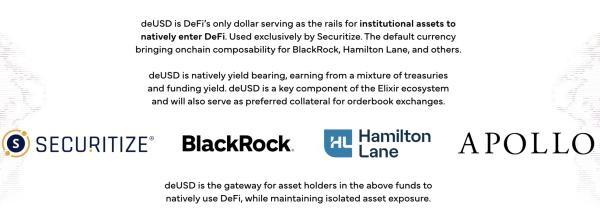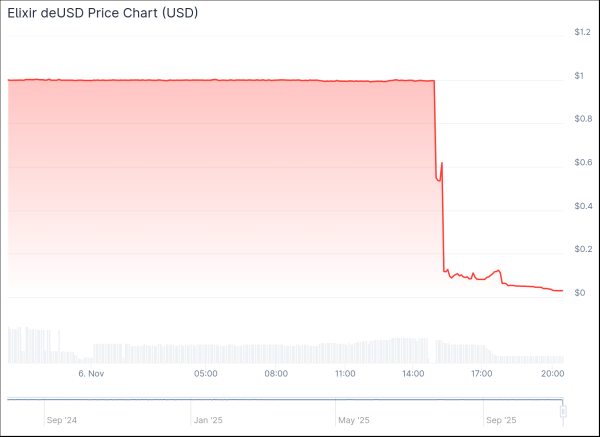Compound Resumes Withdrawals from USDC, USDS Markets

Decentralized crypto lending platform Compound has resumed withdrawals from two out of three of its stablecoin markets where withdrawals had been paused since yesterday. Withdrawals were temporarily paused after risk manager Gauntlet flagged a liquidity crunch tied to institutional liquidity firm Elixir’s deUSD ecosystem.
To prevent potential bad debt, Gauntlet had recommended that Compound institute a temporary emergency pause on withdrawals from the three markets where deUSD and sdUSD are accepted as collateral, namely USDC, USDS, and USDT on Ethereum mainnet.
In a fresh comment on the recommendations from Gauntlet originally posted on Nov. 4, Gauntlet said that Ethereum USDC and USDS market withdrawals were unpaused, “allowing users to resume normal activity.” As for USDT, the comment suggests that users transfer more USDT into the affected market in order “fully cover any temporary reserve gap and provide an additional safety buffer.”
The pause was proposed as a precaution while voting continued on Gauntlet’s separate risk parameter governance proposal, which passed the evening of Nov. 4, and was executed on-chain around 6 p.m. UTC today.
The Pause
In its original recommendation post, Gauntlet explained the reason for the pause, saying that Elixir’s synthetic dollar asset deUSD and its staked counterpart sdeUSD were facing a liquidity crunch, with sdeUSD falling to $0.86 while the protocol’s oracle was still showing the price at $1.06. Per Gauntlet, the price discrepancy is “considered a vulnerability” as it could let borrowers take on more than the market could actually back.
Compound implemented the halt, blocking new borrows and withdrawals while still allowing users to add liquidity, repay loans, or post new collateral.
Compound currently has $2.26 billion locked across its on-chain lending markets, per data from DefiLlama, making it the seventh-largest lending protocol in DeFi
Elixir deUSD Depegs
Meanwhile, around 3 p.m. UTC today, deUSD dropped sharply from around $1 to $0.50, before quickly falling further over the past few hours to approach zero.
Elixir’s website describes deUSD as “the rails for institutional assets to natively enter DeFi,” saying the token is used exclusively by Securitize, and the “gateway for asset holders” in BlackRock, Hamilton Lane and Apollo funds.

Elixir’s deUSD page. Source: Elixir
At press time, the price of deUSD is around $0.028, as it fails to regain its dollar price-peg.

Elixir deUSD 24-hour price chart. Source: CoinGecko
It’s All Connected to Stream
The underlying shock traces back to Stream Finance, the yield optimization protocol that collapsed on Nov. 4, as its own synthetic dollar token, xUSD, collapsed to about $0.17.
As part of a recursive minting agreement with Stream, Elixir reportedly had loaned roughly $68 million to the platform, while accepting xUSD as collateral. In an X post on Nov. 3, before Stream’s full collapse but with concerns already circulating, Elixir said it had “full redemption rights at $1 with Stream for its lending position.”
When Stream disclosed more than $90 million in losses, deUSD and sdeUSD took a hit, triggering cascading stress beyond Compound, and, as of just a few hours ago, resulting in deUSD’s full-blown collapse.
Meanwhile, the price of Compound’s COMP started falling on Nov. 3, as broader markets slumped, but is flat over the past 24 hours.
Ripple Effect
The turmoil also rippled into fastUSD, a synthetic dollar-pegged token backed by deUSD and used across multiple protocols, including Yei Finance, currently the second-largest protocol on the Sei network by TVL.
In a Nov. 5 post on X, Yei Finance said it temporarily paused its protocol, pointing to “the ongoing fastUSD market situation.” The team later said it would repay about $8.6 million in USDC borrowed against staked fastUSD and confirmed that “all user funds on Yei remain fully solvent and will be 100% withdrawable.”
For Yei Finance, the pause comes just a few weeks after it launched its CLO token on Sei and BNB Chain. At that time, on Oct. 14, Yei Finance had nearly $230 million in TVL, representing over 47% of Sei’s DeFi liquidity.
However, as of press time that figure has dropped to $82.6 million.
 Bitcoin
Bitcoin  Ethereum
Ethereum  Tether
Tether  XRP
XRP  USDC
USDC  TRON
TRON  Lido Staked Ether
Lido Staked Ether  Dogecoin
Dogecoin  Figure Heloc
Figure Heloc  Cardano
Cardano  WhiteBIT Coin
WhiteBIT Coin  Bitcoin Cash
Bitcoin Cash  Wrapped stETH
Wrapped stETH  Wrapped Bitcoin
Wrapped Bitcoin  USDS
USDS  Wrapped eETH
Wrapped eETH  Chainlink
Chainlink  Binance Bridged USDT (BNB Smart Chain)
Binance Bridged USDT (BNB Smart Chain)  Monero
Monero  LEO Token
LEO Token  WETH
WETH  Zcash
Zcash  Stellar
Stellar  Hyperliquid
Hyperliquid  Coinbase Wrapped BTC
Coinbase Wrapped BTC  Ethena USDe
Ethena USDe  Litecoin
Litecoin  Sui
Sui  Avalanche
Avalanche  Hedera
Hedera  sUSDS
sUSDS  Shiba Inu
Shiba Inu  Dai
Dai  USDT0
USDT0  Uniswap
Uniswap  PayPal USD
PayPal USD  Cronos
Cronos  Mantle
Mantle  World Liberty Financial
World Liberty Financial  Toncoin
Toncoin  Ethena Staked USDe
Ethena Staked USDe  Canton
Canton  Polkadot
Polkadot  USD1
USD1  Bitget Token
Bitget Token  Rain
Rain  Aave
Aave  MemeCore
MemeCore  OKB
OKB  Tether Gold
Tether Gold  Falcon USD
Falcon USD  Bittensor
Bittensor  NEAR Protocol
NEAR Protocol  Ethereum Classic
Ethereum Classic  Binance-Peg WETH
Binance-Peg WETH  Jito Staked SOL
Jito Staked SOL  BlackRock USD Institutional Digital Liquidity Fund
BlackRock USD Institutional Digital Liquidity Fund  Internet Computer
Internet Computer  Pi Network
Pi Network  Pepe
Pepe  Aster
Aster  Midnight
Midnight  Ethena
Ethena  syrupUSDC
syrupUSDC  Solana
Solana  PAX Gold
PAX Gold  Sky
Sky  HTX DAO
HTX DAO  Jupiter Perpetuals Liquidity Provider Token
Jupiter Perpetuals Liquidity Provider Token  Global Dollar
Global Dollar  Circle USYC
Circle USYC  KuCoin
KuCoin  Ripple USD
Ripple USD  BFUSD
BFUSD  Binance Bridged USDC (BNB Smart Chain)
Binance Bridged USDC (BNB Smart Chain)  Worldcoin
Worldcoin  Ondo
Ondo  Rocket Pool ETH
Rocket Pool ETH  syrupUSDT
syrupUSDT  Aptos
Aptos  Gate
Gate  Binance Staked SOL
Binance Staked SOL  Wrapped BNB
Wrapped BNB  Pump.fun
Pump.fun  POL (ex-MATIC)
POL (ex-MATIC)  Quant
Quant  Arbitrum
Arbitrum  Janus Henderson Anemoy AAA CLO Fund
Janus Henderson Anemoy AAA CLO Fund  Official Trump
Official Trump  Algorand
Algorand  Function FBTC
Function FBTC  Lombard Staked BTC
Lombard Staked BTC  Solv Protocol BTC
Solv Protocol BTC  Filecoin
Filecoin  Cosmos Hub
Cosmos Hub  NEXO
NEXO  VeChain
VeChain  Liquid Staked ETH
Liquid Staked ETH  USDtb
USDtb  USDD
USDD  OUSG
OUSG  Superstate Short Duration U.S. Government Securities Fund (USTB)
Superstate Short Duration U.S. Government Securities Fund (USTB)  WrappedM by M^0
WrappedM by M^0  Sei
Sei  Beldex
Beldex  Arbitrum Bridged WBTC (Arbitrum One)
Arbitrum Bridged WBTC (Arbitrum One)  Polygon Bridged USDC (Polygon PoS)
Polygon Bridged USDC (Polygon PoS)  clBTC
clBTC  Ondo US Dollar Yield
Ondo US Dollar Yield  Mantle Staked Ether
Mantle Staked Ether  Bonk
Bonk  Render
Render  Renzo Restaked ETH
Renzo Restaked ETH  Wrapped Flare
Wrapped Flare  USDai
USDai  MYX Finance
MYX Finance  Polygon PoS Bridged DAI (Polygon POS)
Polygon PoS Bridged DAI (Polygon POS)  PancakeSwap
PancakeSwap  Kinetiq Staked HYPE
Kinetiq Staked HYPE  Jupiter
Jupiter  L2 Standard Bridged WETH (Base)
L2 Standard Bridged WETH (Base)  Jupiter Staked SOL
Jupiter Staked SOL  StakeWise Staked ETH
StakeWise Staked ETH  Pudgy Penguins
Pudgy Penguins  Curve DAO
Curve DAO  Usual USD
Usual USD  c8ntinuum
c8ntinuum  Optimism
Optimism  tBTC
tBTC  Audiera
Audiera  Story
Story  Arbitrum Bridged WETH (Arbitrum One)
Arbitrum Bridged WETH (Arbitrum One)  GHO
GHO  Lido DAO
Lido DAO  Spiko EU T-Bills Money Market Fund
Spiko EU T-Bills Money Market Fund  TrueUSD
TrueUSD  GTETH
GTETH  Dash
Dash  Artificial Superintelligence Alliance
Artificial Superintelligence Alliance  Tezos
Tezos  Injective
Injective  Virtuals Protocol
Virtuals Protocol  Ether.fi
Ether.fi  Merlin Chain
Merlin Chain  Aerodrome Finance
Aerodrome Finance  AB
AB  Stacks
Stacks  SPX6900
SPX6900  Stader ETHx
Stader ETHx  Ether.Fi Liquid ETH
Ether.Fi Liquid ETH  Marinade Staked SOL
Marinade Staked SOL  The Graph
The Graph  Wrapped ApeCoin
Wrapped ApeCoin  Swell Ethereum
Swell Ethereum  Starknet
Starknet  sBTC
sBTC  Celestia
Celestia  FLOKI
FLOKI  JUST
JUST  Maple Finance
Maple Finance  Sun Token
Sun Token  Lorenzo Wrapped Bitcoin
Lorenzo Wrapped Bitcoin  BitTorrent
BitTorrent  Coinbase Wrapped Staked ETH
Coinbase Wrapped Staked ETH  DoubleZero
DoubleZero  Steakhouse USDC Morpho Vault
Steakhouse USDC Morpho Vault  Conflux
Conflux  Bitcoin SV
Bitcoin SV  Ethereum Name Service
Ethereum Name Service  IOTA
IOTA  Telcoin
Telcoin  Chiliz
Chiliz  Olympus
Olympus  Humanity
Humanity  Avalanche Bridged BTC (Avalanche)
Avalanche Bridged BTC (Avalanche)  Kaia
Kaia  Trust Wallet
Trust Wallet  EURC
EURC  AINFT
AINFT  Pyth Network
Pyth Network  Binance-Peg Dogecoin
Binance-Peg Dogecoin  Cap USD
Cap USD  Kinesis Gold
Kinesis Gold  dogwifhat
dogwifhat  Resolv USR
Resolv USR  crvUSD
crvUSD  Gnosis
Gnosis  pippin
pippin 